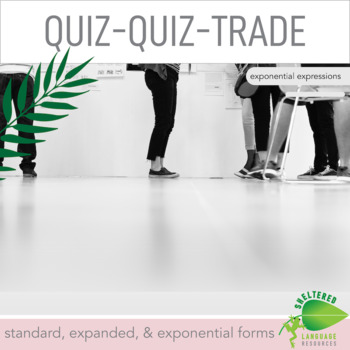Standard form exponential form expanded form Quiz Quiz Trade Game
- PDF
Also included in
- You can have access to all of my math Quiz Quiz Trade games with this growing mega bundle.As I create and upload more QQT games, I'll add them to this bundle and and the price will increase each time.But...once you own it, you can upload the new updates free-of-charge as I release them!These games aPrice $51.00Original Price $66.00Save $15.00
- Buy the entire store of middle school math resources and get free updates for life!All my middle school math resources are created for mainstream classes serving ELLs along with native English speakers.The games and activities use sheltered instructional strategies to target academic vocabulary andPrice $199.00Original Price $240.00Save $41.00
Description
Is an exponential expression written in standard form, expanded form, or exponential form?
I've used these cards in my 6th grade class and 8th grade class and algebra class to introduce or review the concept of the different forms of an exponential expression.
Students are asked to look at an expression that is written in standard form, expanded form, or exponential form. They then use a sentence frame to verbally tell a partner which form the expression is in. For example, they would see the expression 10 x 10 x 10 and say "This number is written in expanded form."
Curious about trying out a Quiz-Quiz-Trade Activity, but not quite ready to commit? Try out this free sample! You could use it as a practice to get students used to the format of the game.
FREE Quiz-Quiz-Trade: Reading Basic Inequalities
Sheltered language strategies are teaching strategies that focus on teaching academic vocabulary at the same time as academic content. These types of strategies have been researched and shown to improve student learning, especially for ELLs. This Quiz-Quiz-Trade (QQT) game combines both academic vocabulary building and student interaction. It is different from many other Quiz-Quiz-Trade games because it provides sentence starters and asks students to read the complete sentence and fill in the answer as an embedded part of the activity. Because of this, students are explicitly required to interact with both academic language and content at the same time.
This resource contains
•36 ready to use QQT cards (4 cards per page, 9 pages)
*If you have more than 36 students in your class, then simply print more cards. The cards will get mixed up and used again anyway, so it does not matter.
How to play Quiz-Quiz-Trade
1.Cut out the playing cards, making sure that one horizontal pair (Quiz Side/Answer Side) is cut as one card.
2.Fold each card in half down the middle, following the dashed line.
3.Give each student one card.
4.Students should hold the card with the Answer Side facing them and the Quiz side facing their partner.
5.Person 1 starts and reads the sentence frame from the Quiz Side of their partner’s card, verbally saying the complete sentence, filling in the blanks. Person 2 checks the answer from the Answer Side of their card, affirming correct answers, or coaching if needed.
6.With the same partner, reverse roles.
7.Trade cards, find a new partner and repeat, switching partners until the teacher stops the game.
Teacher tips
•Play along side your students. Have fun!
•Enforce the use of the sentence frames, that is one of the most important parts!
•Model the game before students play for the first time, focusing on…
•Kind and friendly interactions
•Giving friendly feedback such as “nice work!” or “exactly right!”
•Giving coaching feedback such as “try reading it again and double check your answer”.
•Keeping an appropriate distance from your partner.
•Not too close; no need to hold the card 1 inch from their face.
•Not too far away; they need to be able to see the card.
Looking for more activities & resources about exponent laws? You might like...
Mini Quizzes: Apply exponent Rules
Quiz-Quiz-Trade: Exponential Form, Standard Form, Expanded Form
Quiz-Quiz-Trade: Reading Exponential Expressions Level 1
Exponent Laws- Power to a Power Task Cards
Looking for more Quiz-Quiz-Trade Activities? Check out the resources below:
Quiz-Quiz-Trade: Identify Slope and y-intercept
Quiz-Quiz-Trade: Qualitative, Increasing, and Decreasing Graphs
Quiz-Quiz-Trade: Identify Proportional Relationships
Quiz-Quiz-Trade: Solve Polynomials in Factored Form (Quadratics)
Quiz-Quiz-Trade: Algebra-Reading Function Notation
Quiz-Quiz-Trade: Inequalities-Do You Reverse the Sign?
Quiz-Quiz-Trade: Systems of Linear Equations- Are the Lines Parallel?
Quiz-Quiz-Trade: Systems of Equations-Are the Lines Perpendicular?
Quiz-Quiz-Trade: Sum, Difference, Product, or Quotient?
Quiz-Quiz-Trade: Interpreting the Meaning of Division-Whole Numbers
Quiz-Quiz-Trade: Interpreting Division of a Whole Number by a Unit Fraction
Quiz-Quiz-Trade: Identify the Numerator and Denominator of a Fraction







